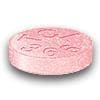Dosage Forms
Excipient information presented when available (limited, particularly for generics); consult specific product labeling. [DSC] = Discontinued product
Suspension, Oral:
Dulcolax Milk of Magnesia: 400 mg/5 mL (355 mL [DSC]) [sugar free]
Dulcolax Milk of Magnesia: 400 mg/5 mL (355 mL [DSC]) [sugar free; contains saccharin sodium]
Milk of Magnesia: 400 mg/5 mL (355 mL, 480 mL)
Milk of Magnesia: 400 mg/5 mL (30 mL) [contains methylparaben, propylene glycol, propylparaben]
Milk of Magnesia: 1200 mg/15 mL (355 mL [DSC])
Milk of Magnesia: 1200 mg/15 mL (355 mL [DSC]) [mint flavor]
Milk of Magnesia: 7.75% (360 mL, 480 mL)
Milk of Magnesia: 7.75% (355 mL [DSC], 473 mL) [mint flavor]
Milk of Magnesia: 7.75% (30 mL) [spearmint flavor]
Milk of Magnesia: 2400 mg/30 mL (30 mL) [alcohol free, dye free, sugar free]
Milk of Magnesia: 1200 mg/15 mL (355 mL) [cramp free, gluten free, stimulant free, sugar free; original flavor]
Milk of Magnesia: 1200 mg/15 mL (355 mL) [cramp free, gluten free, stimulant free, sugar free; contains saccharin sodium; mint flavor]
Milk of Magnesia: 1200 mg/15 mL (355 mL) [cramp free, stimulant free, sugar free; contains saccharin sodium]
Milk of Magnesia: 1200 mg/15 mL (355 mL) [gluten free, stimulant free, sugar free; unflavored flavor]
Milk of Magnesia: 1200 mg/15 mL (355 mL) [gluten free, stimulant free, sugar free; contains saccharin sodium]
Milk of Magnesia: 400 mg/5 mL (355 mL [DSC], 473 mL) [low sodium, sugar free]
Milk of Magnesia: 400 mg/5 mL (355 mL, 473 mL, 769 mL [DSC], 3780 mL) [stimulant free, sugar free]
Milk of Magnesia: 400 mg/5 mL (473 mL); 1200 mg/15 mL (355 mL [DSC]) [sugar free]
Milk of Magnesia Concentrate: 2400 mg/10 mL (100 mL, 400 mL) [lemon flavor]
Milk of Magnesia Concentrate: 2400 mg/10 mL (10 mL) [contains methylparaben, propylene glycol, propylparaben, saccharin sodium; lemon flavor]
Milk of Magnesia Concentrate: 2400 mg/10 mL (10 mL) [alcohol free, dye free, sugar free]
Phillips Milk of Magnesia: 400 mg/5 mL (355 mL) [cramp free, stimulant free, sugar free]
Tablet Chewable, Oral:
Pedia-Lax: 400 mg [scored; stimulant free; contains fd&c red #40 aluminum lake; watermelon flavor]
Phillips: 311 mg [DSC]
Pharmacology
Mechanism of Action
Promotes bowel evacuation by causing osmotic retention of fluid which distends the colon with increased peristaltic activity; reacts with hydrochloric acid in stomach to form magnesium chloride
Pharmacokinetics/Pharmacodynamics
Absorption
Oral: Up to 30%
Excretion
Urine (up to 30% as absorbed magnesium ions); feces (as unabsorbed drug)
Onset of Action
Laxative: 30 minutes to 6 hours
Use: Labeled Indications
Antacid: For the temporary relief of heartburn, upset stomach, sour stomach, or acid indigestion.
Laxative (occasional constipation): For relief of occasional constipation. This product generally produces bowel movement in 30 minutes to 6 hours.
Contraindications
Hypersensitivity to any ingredient
Dosage and Administration
Dosing: Adult
Antacid: OTC labeling: Oral:
Liquid: Magnesium hydroxide 400 mg/5 mL: 5 to 15 mL as needed up to 4 times/day; do not exceed 60 mL in 24 hours
Tablet, chewable: Magnesium hydroxide 311 mg/tablet: 2 to 4 tablets every 4 hours up to 4 times/day; do not exceed 4 doses in 24 hours
Laxative (occasional constipation): OTC labeling: Oral:
Liquid:
Magnesium hydroxide 400 mg/5 mL: 30 to 60 mL/day once daily at bedtime or in divided doses
Magnesium hydroxide 800 mg/5 mL: 15 to 30 mL/day once daily at bedtime or in divided doses
Magnesium hydroxide 1,200 mg/5 mL: 10 to 20 mL/day once daily at bedtime or in divided doses
Tablet, chewable: Magnesium hydroxide 311 mg/tablet: 8 tablets/day once daily at bedtime or in divided doses
Dosing: Geriatric
Refer to adult dosing.
Dosing: Pediatric
Note: Dose expressed as mg of magnesium hydroxide.
Antacid: Oral: Children ≥12 years and Adolescents (Phillips 311 mg chewable tablet): 2 to 4 tablets every 4 hours up to 4 times per day. Do not exceed 4 doses in 24 hours.
Constipation, chronic: Oral: Infants, Children, and Adolescents: Limited data available: 80 to 240 mg/kg/day divided once or twice daily (Wyllie 2011); usual adult dose is 2,400 to 4,800 mg/day
Constipation, occasional: Oral:
Children 2 to <6 years: 400 to 1,200 mg/day in single or divided doses. Maximum daily dose: 1,200 mg/day
Children 6 to <12 years: 1,200 to 2,400 mg/day in single or divided doses. Maximum daily dose: 2,400 mg/day
Children ≥12 years and Adolescents: 2,400 to 4,800 mg/day in single or divided doses. Maximum daily dose: 4,800 mg/day
Fecal impaction, slow disimpaction: Limited data available: Oral: Children and Adolescents: 160 mg/kg twice daily for 7 days (Pashankar 2005; Wyllie 2011)
Administration
Shake liquids well before using. All doses should be followed by 8 ounces of water.
Dietary Considerations
Some products may contain sodium.
Storage
Keep tightly closed. Store at 20°C to 25°C (68°F to 77°F). Protect from freezing.
Magnesium Hydroxide Images
Drug Interactions
Acalabrutinib: Antacids may decrease the serum concentration of Acalabrutinib. Management: Separate administration of acalabrutinib from the administration of any antacids by at least 2 hours in order to minimize the potential for a significant interaction. Consider therapy modification
Alfacalcidol: May increase the serum concentration of Magnesium Salts. Consider therapy modification
Allopurinol: Antacids may decrease the absorption of Allopurinol. Consider therapy modification
Alpha-Lipoic Acid: Magnesium Salts may decrease the absorption of Alpha-Lipoic Acid. Alpha-Lipoic Acid may decrease the absorption of Magnesium Salts. Consider therapy modification
Amphetamines: Antacids may decrease the excretion of Amphetamines. Monitor therapy
Antipsychotic Agents (Phenothiazines): Antacids may decrease the absorption of Antipsychotic Agents (Phenothiazines). Monitor therapy
Atazanavir: Antacids may decrease the absorption of Atazanavir. Consider therapy modification
Baloxavir Marboxil: Polyvalent Cation Containing Products may decrease the serum concentration of Baloxavir Marboxil. Avoid combination
Bictegravir: Polyvalent Cation Containing Products may decrease the serum concentration of Bictegravir. Management: Administer bictegravir under fasting conditions at least 2 hours before or 6 hours after polyvalent cation containing products. Coadministration of bictegravir with or 2 hours after most polyvalent cation products is not recommended. Consider therapy modification
Bisacodyl: Antacids may diminish the therapeutic effect of Bisacodyl. Antacids may cause the delayed-release bisacodyl tablets to release drug prior to reaching the large intestine. Gastric irritation and/or cramps may occur. Consider therapy modification
Bismuth Subcitrate: Antacids may diminish the therapeutic effect of Bismuth Subcitrate. Management: Avoid administration of antacids within 30 minutes of bismuth subcitrate (tripotassium bismuth dicitrate) administration. Consider therapy modification
Bisphosphonate Derivatives: Polyvalent Cation Containing Products may decrease the serum concentration of Bisphosphonate Derivatives. Management: Avoid administration of oral medications containing polyvalent cations within: 2 hours before or after tiludronate/clodronate/etidronate; 60 minutes after oral ibandronate; or 30 minutes after alendronate/risedronate. Exceptions: Pamidronate; Zoledronic Acid. Consider therapy modification
Bosutinib: Antacids may decrease the serum concentration of Bosutinib. Management: Administer antacids more than 2 hours before or after bosutinib. Consider therapy modification
Bromperidol: Antacids may decrease the absorption of Bromperidol. Monitor therapy
Calcitriol (Systemic): May increase the serum concentration of Magnesium Salts. Management: Consider using a non-magnesium-containing antacid or phosphate-binding product in patients also receiving calcitriol. If magnesium-containing products must be used with calcitriol, serum magnesium concentrations should be monitored closely. Consider therapy modification
Calcium Channel Blockers: May enhance the adverse/toxic effect of Magnesium Salts. Magnesium Salts may enhance the hypotensive effect of Calcium Channel Blockers. Monitor therapy
Calcium Polystyrene Sulfonate: Laxatives (Magnesium Containing) may enhance the adverse/toxic effect of Calcium Polystyrene Sulfonate. More specifically, concomitant use of calcium polystyrene sulfonate with magnesium-containing laxatives may result in metabolic alkalosis or with sorbitol may result in intestinal necrosis. Management: Avoid concomitant use of calcium polystyrene sulfonate (rectal or oral) and magnesium-containing laxatives. Avoid combination
Captopril: Antacids may decrease the serum concentration of Captopril. Monitor therapy
Cefditoren: Antacids may decrease the serum concentration of Cefditoren. Management: Concomitant use of cefditoren with antacids is not recommended. Consider alternative methods to control acid reflux (eg, diet modification) or alternative antimicrobial therapy. If antacid therapy can not be avoided, separate dosing by several hours. Consider therapy modification
Cefpodoxime: Antacids may decrease the serum concentration of Cefpodoxime. Monitor therapy
Cefuroxime: Antacids may decrease the serum concentration of Cefuroxime. Management: Administer cefuroxime axetil at least 1 hour before or 2 hours after the administration of short-acting antacids. Consider therapy modification
Chloroquine: Antacids may decrease the serum concentration of Chloroquine. Management: Separate administration of antacids and chloroquine by at least 4 hours to minimize any potential negative impact of antacids on chloroquine bioavailability. Consider therapy modification
Corticosteroids (Oral): Antacids may decrease the bioavailability of Corticosteroids (Oral). Management: Consider separating doses by 2 or more hours. Budesonide enteric coated tablets could dissolve prematurely if given with drugs that lower gastric acid, with unknown impact on budesonide therapeutic effects. Consider therapy modification
Cysteamine (Systemic): Antacids may diminish the therapeutic effect of Cysteamine (Systemic). Monitor therapy
Dabigatran Etexilate: Antacids may decrease the serum concentration of Dabigatran Etexilate. Management: Dabigatran etexilate Canadian product labeling recommends avoiding concomitant use with antacids for 24 hours after surgery. In other situations, administer dabigatran etexilate 2 hours prior to antacids. Monitor clinical response to dabigatran therapy. Consider therapy modification
Dasatinib: Antacids may decrease the serum concentration of Dasatinib. Management: Simultaneous administration of dasatinib and antacids should be avoided. Administer antacids 2 hours before or 2 hours after dasatinib. Consider therapy modification
Deferiprone: Polyvalent Cation Containing Products may decrease the serum concentration of Deferiprone. Management: Separate administration of deferiprone and oral medications or supplements that contain polyvalent cations by at least 4 hours. Consider therapy modification
Delavirdine: Antacids may decrease the serum concentration of Delavirdine. Management: Separate doses of delavirdine and antacids by at least 1 hour. Monitor for decreased delavirdine therapeutic effects with this combination. Consider therapy modification
Dexmethylphenidate: Antacids may increase the absorption of Dexmethylphenidate. Specifically, antacids may interfere with the normal release of drug from the extended-release capsules (Focalin XR brand), which could result in both increased absorption (early) and decreased delayed absorption. Monitor therapy
Diacerein: Antacids may decrease the absorption of Diacerein. Monitor therapy
Dichlorphenamide: Laxatives may enhance the hypokalemic effect of Dichlorphenamide. Monitor therapy
Dolutegravir: Magnesium Salts may decrease the serum concentration of Dolutegravir. Management: Administer dolutegravir at least 2 hours before or 6 hours after oral magnesium salts. Administer the dolutegravir/rilpivirine combination product at least 4 hours before or 6 hours after oral magnesium salts. Consider therapy modification
Doxercalciferol: May enhance the hypermagnesemic effect of Magnesium Salts. Management: Consider using a non-magnesium-containing antacid or phosphate-binding product in patients also receiving doxercalciferol. If magnesium-containing products must be used with doxercalciferol, serum magnesium concentrations should be monitored closely. Consider therapy modification
Eltrombopag: Polyvalent Cation Containing Products may decrease the serum concentration of Eltrombopag. Management: Administer eltrombopag at least 2 hours before or 4 hours after oral administration of any polyvalent cation containing product. Consider therapy modification
Elvitegravir: Antacids may decrease the serum concentration of Elvitegravir. Management: Separate administration of antacids and elvitegravir-containing products by at least 2 hours in order to minimize the risk for an interaction. Consider therapy modification
Erdafitinib: Serum Phosphate Level-Altering Agents may diminish the therapeutic effect of Erdafitinib. Management: Avoid coadministration of serum phosphate level-altering agents with erdafitinib before initial dose increase period based on serum phosphate levels (Days 14 to 21). Consider therapy modification
Erlotinib: Antacids may decrease the serum concentration of Erlotinib. Management: Separate the administration of erlotinib and any antacid by several hours in order to minimize the risk of a significant interaction. Consider therapy modification
Fexofenadine: Antacids may decrease the serum concentration of Fexofenadine. Management: Separate the administration of fexofenadine and aluminum- or magnesium-containing antacids. Consider therapy modification
Fosinopril: Antacids may decrease the serum concentration of Fosinopril. Management: The US and Canadian fosinopril manufacturer labels recommend separating the doses of antacids and fosinopril by 2 hours. Consider therapy modification
Gabapentin: Magnesium Salts may enhance the CNS depressant effect of Gabapentin. Specifically, high dose intravenous/epidural magnesium sulfate may enhance the CNS depressant effects of gabapentin. Magnesium Salts may decrease the serum concentration of Gabapentin. Management: Administer gabapentin at least 2 hours after use of a magnesium-containing antacid. Monitor patients closely for evidence of reduced response to gabapentin therapy. Monitor for CNS depression if high dose IV/epidural magnesium sulfate is used. Consider therapy modification
Gefitinib: Antacids may decrease the serum concentration of Gefitinib. Management: Administer gefitinib at least 6 hours before or after administration of an antacid, and closely monitor clinical response to gefitinib. Consider therapy modification
Hyoscyamine: Antacids may decrease the serum concentration of Hyoscyamine. Management: Administer immediate release hyoscyamine before meals and antacids after meals when these agents are given in combination. Consider therapy modification
Iron Preparations: Antacids may decrease the absorption of Iron Preparations. Management: Separate dosing of oral iron preparations and antacids as much as possible to avoid decreased efficacy of iron preparation. If coadministered with antacids, monitor for decreased therapeutic effects of iron preparations. Exceptions: Ferric Carboxymaltose; Ferric Citrate; Ferric Derisomaltose; Ferric Gluconate; Ferric Hydroxide Polymaltose Complex; Ferric Pyrophosphate Citrate; Ferumoxytol; Iron Dextran Complex; Iron Sucrose. Consider therapy modification
Itraconazole: Antacids may decrease the serum concentration of Itraconazole. Antacids may increase the serum concentration of Itraconazole. Management: Administer Sporanox brand itraconazole at least 2 hours before or 2 hours after administration of any antacids. Exposure to Tolsura brand itraconazole may be increased by antacids; consider itraconazole dose reduction. Consider therapy modification
Ketoconazole (Systemic): Antacids may decrease the serum concentration of Ketoconazole (Systemic). Management: Administer oral ketoconazole at least 2 hours prior to use of any antacid product. Monitor patients closely for signs of inadequate clinical response to ketoconazole. Consider therapy modification
Lanthanum: Antacids may diminish the therapeutic effect of Lanthanum. Consider therapy modification
Ledipasvir: Antacids may decrease the serum concentration of Ledipasvir. Management: Separate the administration of ledipasvir and antacids by 4 hours. Consider therapy modification
Levothyroxine: Magnesium Salts may decrease the serum concentration of Levothyroxine. Management: Separate administration of oral levothyroxine and oral magnesium salts by at least 4 hours. Consider therapy modification
Mesalamine: Antacids may diminish the therapeutic effect of Mesalamine. Antacid-mediated increases in gastrointestinal pH may cause the premature release of mesalamine from specific sustained-release mesalamine products. Management: Avoid concurrent administration of antacids with sustained-release mesalamine products. Separating antacid and mesalamine administration, and/or using lower antacid doses may be adequate means of avoiding this interaction. Consider therapy modification
Methenamine: Antacids may diminish the therapeutic effect of Methenamine. Consider therapy modification
Methylphenidate: Antacids may increase the absorption of Methylphenidate. Specifically, antacids may interfere with the normal release of drug from the extended-release capsules (Ritalin LA brand), which could result in both increased absorption (early) and decreased delayed absorption. Monitor therapy
MiSOPROStol: Antacids may enhance the adverse/toxic effect of MiSOPROStol. More specifically, concomitant use with magnesium-containing antacids may increase the risk of diarrhea. Management: Avoid concomitant use of misoprostol and magnesium-containing antacids. In patients requiring antacid therapy, employ magnesium-free preparations. Monitor for increased adverse effects (e.g., diarrhea, dehydration). Avoid combination
Multivitamins/Fluoride (with ADE): Magnesium Salts may decrease the serum concentration of Multivitamins/Fluoride (with ADE). Specifically, magnesium salts may decrease fluoride absorption. Management: To avoid this potential interaction separate the administration of magnesium salts from administration of a fluoride-containing product by at least 1 hour. Consider therapy modification
Multivitamins/Minerals (with ADEK, Folate, Iron): Antacids may decrease the serum concentration of Multivitamins/Minerals (with ADEK, Folate, Iron). Specifically, antacids may decrease the absorption of orally administered iron. Management: Separate dosing of oral iron-containing multivitamin preparations and antacids by as much time as possible in order to minimize impact on therapeutic efficacy of the iron preparation. Consider therapy modification
Mycophenolate: Antacids may decrease the absorption of Mycophenolate. Management: Separate doses of mycophenolate and antacids by at least 2 hours. Monitor for reduced effects of mycophenolate if taken concomitant with antacids. Consider therapy modification
Mycophenolate: Magnesium Salts may decrease the serum concentration of Mycophenolate. Management: Separate doses of mycophenolate and oral magnesium salts. Monitor for reduced effects of mycophenolate if taken concomitant with oral magnesium salts. Consider therapy modification
Neratinib: Antacids may decrease the serum concentration of Neratinib. Specifically, antacids may reduce neratinib absorption. Management: Separate the administration of neratinib and antacids by giving neratinib at least 3 hours after the antacid. Consider therapy modification
Neuromuscular-Blocking Agents: Magnesium Salts may enhance the neuromuscular-blocking effect of Neuromuscular-Blocking Agents. Monitor therapy
Nilotinib: Antacids may decrease the serum concentration of Nilotinib. Management: Separate the administration of nilotinib and any antacid by at least 2 hours whenever possible in order to minimize the risk of a significant interaction. Consider therapy modification
PAZOPanib: Antacids may decrease the serum concentration of PAZOPanib. Management: Avoid the use of antacids in combination with pazopanib whenever possible. Separate doses by several hours if antacid treatment is considered necessary. The impact of dose separation has not been investigated. Consider therapy modification
PenicillAMINE: Polyvalent Cation Containing Products may decrease the serum concentration of PenicillAMINE. Management: Separate the administration of penicillamine and oral polyvalent cation containing products by at least 1 hour. Consider therapy modification
Pexidartinib: Antacids may decrease the serum concentration of Pexidartinib. Management: Administer pexidartinib 2 hours before or after antacids. Consider therapy modification
Phosphate Supplements: Antacids may decrease the absorption of Phosphate Supplements. Management: This applies only to oral phosphate administration. Separating administer of oral phosphate supplements from antacid administration by as long as possible may minimize the interaction. Exceptions: Sodium Glycerophosphate Pentahydrate. Consider therapy modification
Phosphate Supplements: Magnesium Salts may decrease the serum concentration of Phosphate Supplements. Management: Administer oral phosphate supplements as far apart from the administration of an oral magnesium salt as possible to minimize the significance of this interaction. Exceptions: Sodium Glycerophosphate Pentahydrate. Consider therapy modification
Potassium Phosphate: Antacids may decrease the serum concentration of Potassium Phosphate. Management: Consider separating administration of antacids and oral potassium phosphate by at least 2 hours to decrease risk of a significant interaction. Consider therapy modification
QuiNIDine: Antacids may decrease the excretion of QuiNIDine. Monitor therapy
QuiNINE: Antacids may decrease the serum concentration of QuiNINE. Avoid combination
Quinolones: Antacids may decrease the absorption of Quinolones. Of concern only with oral administration of quinolones. Management: Avoid concurrent administration of quinolones and antacids to minimize the impact of this interaction. Recommendations for optimal dose separation vary by specific quinolone. Exceptions: LevoFLOXacin (Oral Inhalation). Consider therapy modification
Quinolones: Magnesium Salts may decrease the serum concentration of Quinolones. Management: Administer oral quinolones several hours before (4 h for moxi/pe/spar-, 2 h for others) or after (8 h for moxi-, 6 h for cipro/dela-, 4 h for lome/pe-, 3 h for gemi-, and 2 h for levo-, nor-, or ofloxacin or nalidixic acid) oral magnesium salts. Exceptions: LevoFLOXacin (Oral Inhalation). Consider therapy modification
Raltegravir: Magnesium Salts may decrease the serum concentration of Raltegravir. Management: Avoid the use of oral / enteral magnesium salts with raltegravir. No dose separation schedule has been established that adequately reduces the magnitude of interaction. Avoid combination
Rilpivirine: Antacids may decrease the serum concentration of Rilpivirine. Management: Administer antacids at least 2 hours before or 4 hours after rilpivirine. Administer antacids at least 6 hours before or 4 hours after the rilpivirine/dolutegravir combination product. Consider therapy modification
Riociguat: Antacids may decrease the serum concentration of Riociguat. Management: Separate the administration of antacids and riociguat by at least 1 hour in order to minimize any potential interaction. Consider therapy modification
Rosuvastatin: Antacids may decrease the serum concentration of Rosuvastatin. Monitor therapy
Sodium Polystyrene Sulfonate: Laxatives (Magnesium Containing) may enhance the adverse/toxic effect of Sodium Polystyrene Sulfonate. More specifically, concomitant use of sodium polystyrene sulfonate with magnesium-containing laxatives may result in metabolic alkalosis or with sorbitol may result in intestinal necrosis. Management: Avoid concomitant use of sodium polystyrene sulfonate (rectal or oral) and magnesium-containing laxatives. Avoid combination
Sotalol: Antacids may decrease the serum concentration of Sotalol. Management: Avoid simultaneous administration of sotalol and antacids. Administer antacids 2 hours after sotalol. Consider therapy modification
Strontium Ranelate: Magnesium Hydroxide may decrease the serum concentration of Strontium Ranelate. Management: Separate administration of strontium ranelate and magnesium hydroxide by at least 2 hours whenever possible in order to minimize this interaction. Consider therapy modification
Sulpiride: Antacids may decrease the serum concentration of Sulpiride. Management: Separate administration of antacids and sulpiride by at least 2 hours in order to minimize the impact of antacids on sulpiride absorption. Consider therapy modification
Tetracyclines: Antacids may decrease the absorption of Tetracyclines. Management: Separate administration of antacids and oral tetracycline derivatives by several hours when possible to minimize the extent of this potential interaction. Exceptions: Eravacycline. Consider therapy modification
Tetracyclines: Magnesium Salts may decrease the absorption of Tetracyclines. Only applicable to oral preparations of each agent. Exceptions: Eravacycline. Consider therapy modification
Trientine: Polyvalent Cation Containing Products may decrease the serum concentration of Trientine. Management: Avoid concomitant administration of trientine and oral products that contain polyvalent cations. If oral iron supplements are required, separate the administration by 2 hours. If other oral polyvalent cations are needed, separate administration by 1 hour. Consider therapy modification
Velpatasvir: Antacids may decrease the serum concentration of Velpatasvir. Management: Separate administration of velpatasvir and antacids by at least 4 hours. Consider therapy modification
Test Interactions
Increased magnesium; decreased protein, calcium (S), decreased potassium (S)
Warnings/Precautions
Disease-related concerns:
- Neuromuscular disease: Use with extreme caution in patients with myasthenia gravis or other neuromuscular disease.
- Renal impairment: Use with caution in patients with renal impairment; accumulation of magnesium may lead to magnesium intoxication.
Other warnings/precautions:
- OTC use: For occasional use only; serious side effects may occur with prolonged use. For use only under the supervision of a health care provider in patients with kidney dysfunction, a magnesium-restricted diet, stomach pain/nausea/vomiting, or with a sudden change in bowel habits which persist for >2 weeks. Patients should stop use as a laxative and notify health care provider of any rectal bleeding, if bowel movement does not occur after using product, or if use is needed for >1 week. Stop use as an antacid and notify health care provider if you have taken the maximum dose for >2 weeks. Not for OTC use in children <2 years of age.
Pregnancy
Pregnancy Considerations
Magnesium crosses the placenta; serum concentrations in the fetus are similar to those in the mother (Idama 1998; Osada 2002). Magnesium hydroxide is considered to be acceptable for treating heartburn of pregnancy, as well as aspiration prophylaxis during labor (Richter [ACG 2007])
Patient Education
What is this drug used for?
- It is used to treat constipation.
- It is used to treat heartburn and upset stomach.
Frequently reported side effects of this drug
- Diarrhea
- Signs of a significant reaction like wheezing; chest tightness; fever; itching; bad cough; blue skin color; seizures; or swelling of face, lips, tongue, or throat.
Note: This is not a comprehensive list of all side effects. Talk to your doctor if you have questions.
Consumer Information Use and Disclaimer: This information should not be used to decide whether or not to take this medicine or any other medicine. Only the healthcare provider has the knowledge and training to decide which medicines are right for a specific patient. This information does not endorse any medicine as safe, effective, or approved for treating any patient or health condition. This is only a brief summary of general information about this medicine. It does NOT include all information about the possible uses, directions, warnings, precautions, interactions, adverse effects, or risks that may apply to this medicine. This information is not specific medical advice and does not replace information you receive from the healthcare provider. You must talk with the healthcare provider for complete information about the risks and benefits of using this medicine.





